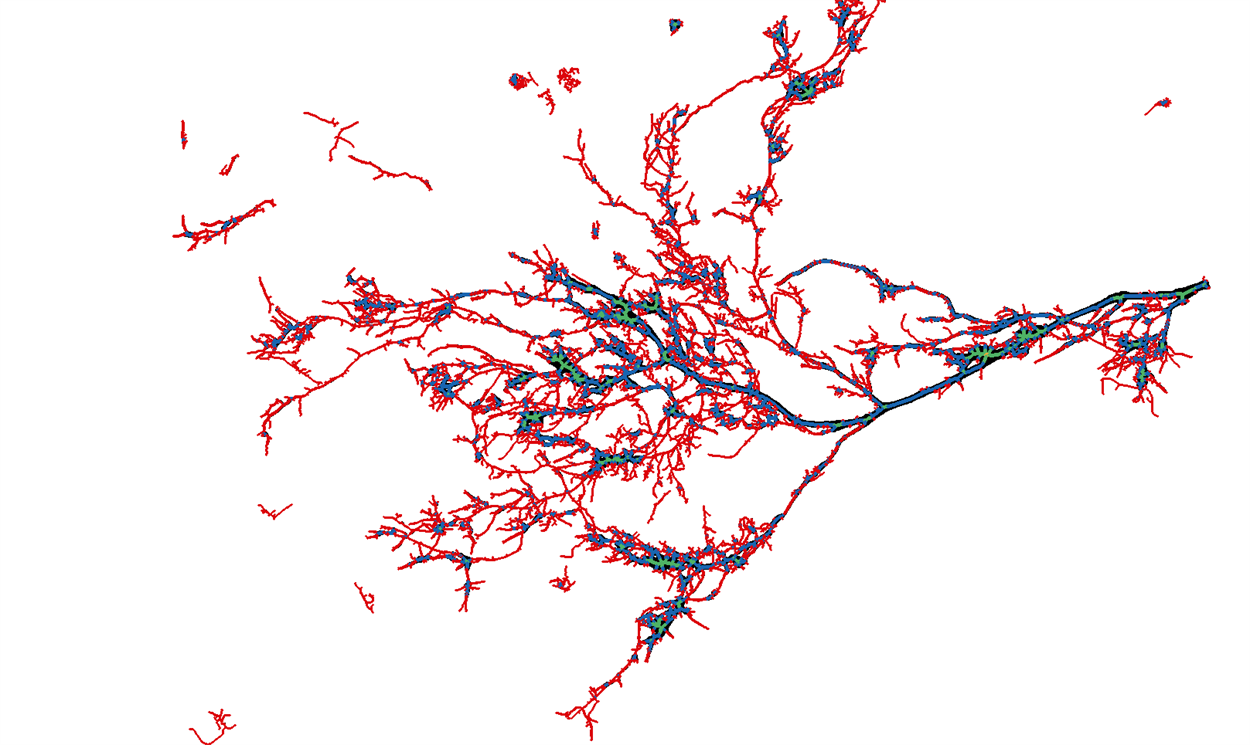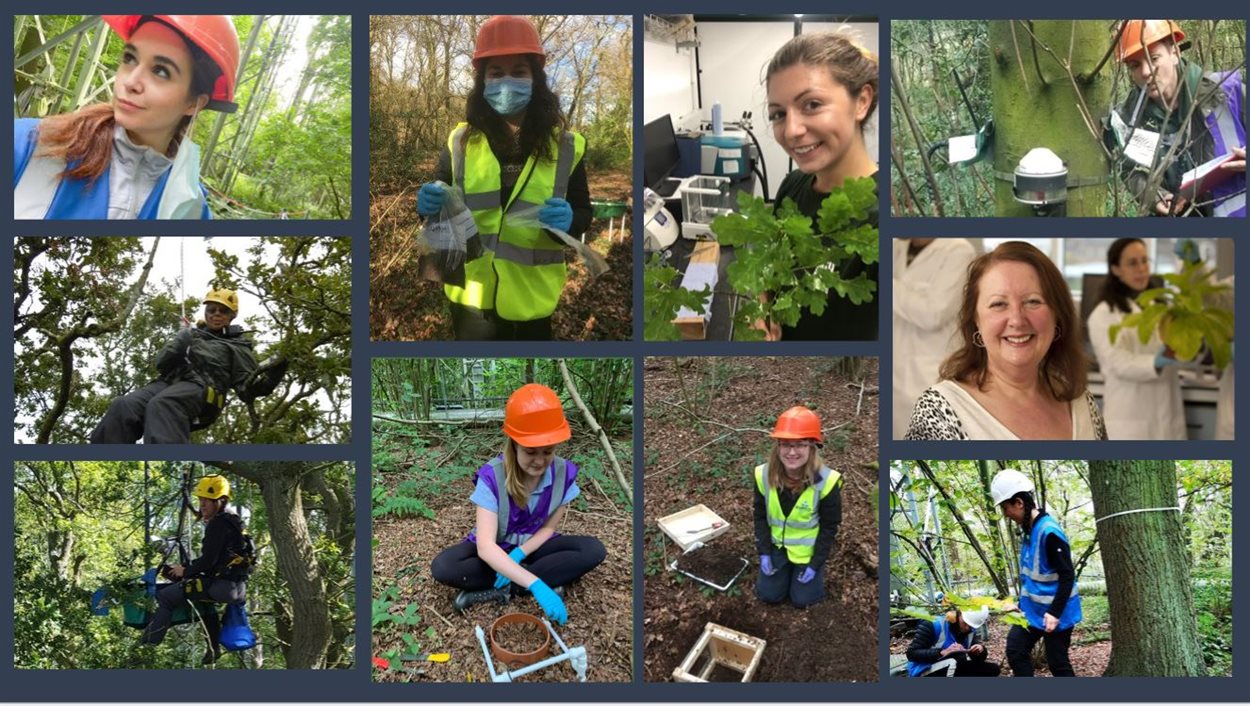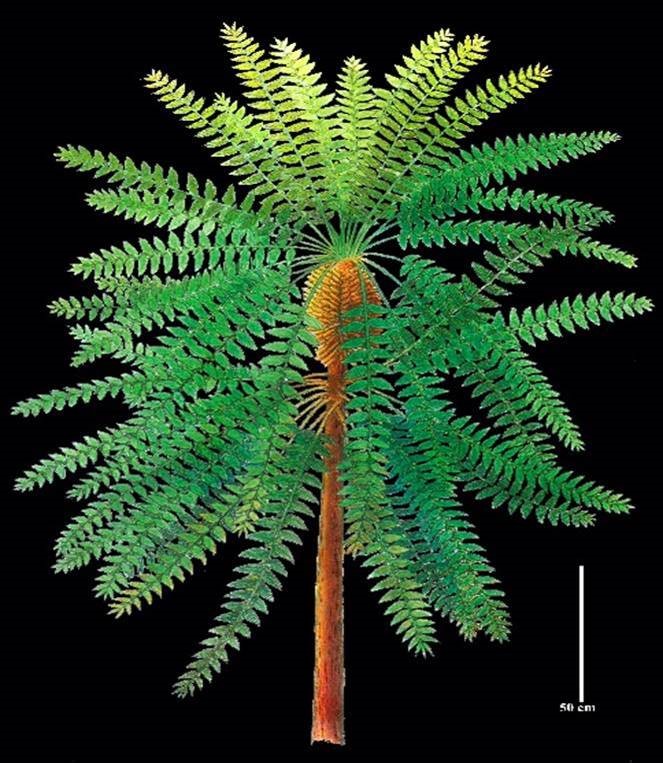FACE - Underground, Drs Michaela Reay and Sami Ullah

Oak roots collected during root exudate work as part of the NERC funded FACE-Underground research project. Roots are scanned and analysed to determine diameter. Analysis is completed using RhizoVision Explorer. Roots are shown in difference colours (red for roots less than 0.5 mm, blue for roots 0.5 to 1 mm and green for roots 1 to 2 mm. Image credit: Dr Michaela Reay
Nutrients, especially nitrogen and phosphorus, constrain the increase in carbon capture by forests through photosynthesis under elevated atmospheric carbon dioxide (eCO2). Neglecting the role of nutrients may overestimate CO2 uptake rates by as much as 50%. We urgently need a realistic assessment of the role of nutrients in controlling forest responses to eCO2. The NERC-funded FACE-Underground project investigates whether mature trees gain greater access to limiting nutrients in soils under eCO2 and, if so, which strategies do they employ? We are using the unique BIFoR-FACE facility to investigate whether higher CO2 in the atmosphere increases carbon allocation belowground, whether this can then “prime” decomposition by soil microbes, and whether nitrogen and phosphorus availability is thereby increased.
FACE-Underground quantifies changes in root and associated mycorrhizal biomass and turnover, and changes in root exudation rates and chemistry. In the picture above, we are using root boxes to (literally) provide a window into the soil for tracking root morphology and for collecting exudates from intact roots (see, e.g., the striking example of a scanned root, above). FACE-Underground looks at the roles of roots versus mycorrhizal fungi, and root exudation, in controlling decomposition and nutrient availability, and how all this is affected by eCO2. We will determine if trees are altering their preference and rate of uptake for different nitrogen forms in soils under eCO2, and how this relates to their availability, in light of key nitrogen cycling processes. The project will generate the very first detailed assessment of whether, and how, mature trees can increase nutrient uptake under eCO2. Future climate predictions depend critically on such mechanistic understanding.
Conferences in 2021
The BIFoR 5th Annual Community Meetin was held virtually on 27 & 28 of January 2021 and focused on pests,disease and their impacts to trees. We announced (i) funding to secure BIFoR FACE operation to the end of 2026: £5 million & £6.3 million from the JABBS Foundation & University of Birmingham; and (ii) Jon Drori has joined us as an honorary professor, to develop our science communications.
Over 300 attended, including many international delegates. Recordings are available online, as are the posters by the 38-strong postgraduate researcher team.

The BIFoR Annual Meeting and social media on International Women’s Day, shone a much-deserved spotlight on emerging and current female talent in BIFoR.
Hold the dates
6,7,8 July 2021 (new dates) Treescapes 2021 (virtual) A unique event being led by early career researchers from a number of UK universities and disciplines to stimulate conversations between the research and woodland practitioner communities.
3rd to 4th November 2021 Trees for the Future - Diversity and complexity for resilience and carbon storage. A conference to explore state-of-theart scientific evidence on the use of tree species diversity for higher productivity, lower susceptibility to biotic and abiotic stress, strategies to deliver a portfolio of ecosystem services, along with economic & management benefits. Poster submission deadline 31 May 2021.
Forest health research news
As part of the EU-funded VIROPLANT project, Mojgan Rabiey and Rob Jackson isolated and characterised bacteriophages (virus that kills bacteria) to examine their use as a potential biological control of bacterial canker of cherry (see Rabiey et al., 2020). The bacteriophages had a specific host range, able to lyse strains of Pseudomonas syringae pv. syringae and P. syringae pv. morsprunorum, causative agents of cherry canker. Application of the phage could effectively reduce bacterial disease progression and infectivity in vitro and in different plant systems, with no effect on beneficial bacteria. Genome sequencing revealed some of these bacteriophage were new discoveries and did not carry toxins, indicating their use as an environmentally friendly biocontrol agent in cherry industry and in agriculture. Since joining BIFoR, Mojgan has started work on a related BBSRC-funded project, trying to understand how new strains of cherry pathogens emerge and evolve on trees. In specific, she will be looking at genetic mechanisms of host range expansion and how phage can mediate gene exchange between bacteria. We also welcome Sophie Malkin who has started her technician role in BIFoR supporting the tree pathology research in Rob’s lab. Sophie brings several years of lab management experience and is a great addition to our group.
BIFoR FACE research news
Congratulations to Liam Crowley, Angeliki Kourmouli & Clare Ziegler who have submitted their PhD theses & Nicolai Brekenfeld who successfully defended his viva. Bridget Warren has won two competitive and prestigious funding awards recently. The awards will facilitate measurements of compound-specific carbon and hydrogen isotopes of leaf waxes in elevated carbon dioxide (CO2). A new paper has been published: MacKenzie et al. ‘BIFoR FACE: Water soil vegetation atmosphere data from a temperate deciduous forest catchment, including underelevated CO2 Hydrological Processes Special Issue. All FACE publications are listed on our website.

Essential tower maintenance ahead of the new CO2 elevation season in April. Thanks to the hard work of this team the FACE facility remained open for research and elevated levels of CO2 continued to reach our experimental patches throughout the 2020 growing season.
We celebrate with Prof Jon Drori on his new book "Around the world in 80 plants"; Dr Adriane-Esquivel Muelbert who was winner of the Forests 2020 Young Investigator Award and lead for the successful International Tree Mortality Webinar series; Dr Emma Ferranti who has been appointed to the Forestry Commission’s West Midlands Forest and Woodland Advisory Committee; Dr Nick Kettridge has been awarded €300,000 by the Irish Environment Protection Agency to investigate “Peatland Resilience to changing climate and increased frequency and severity of drought”; Dr Josh Larsen who has been appointed to the independent scientific advisory panel of the UK Beaver Trust; Dr Tom Matthews for his recent book “The Species-Area Relationship: Theory & Application’; Dr Frank Uekotter (History) has been awarded a European Research Council Advanced Grant to continue his research into the “monoculture mind set” (forestry and agriculture). We welcome visiting FLAIR/Royal Society fellow Dr Ola Olujimi (environmental health impacts of charcoal production in Africa); Dr Susanne Suvanto joining on a 2-year Marie Curie fellowship (ForMMI); PhD students Nigar Parvin (green infrastructure and cooling of the urban heat island), Manon Rumeau (nitrogen fixation), Bruno Santos (wastewater treatment & trees). The Forest Health team has also expanded (see above).
Research highlight:
Spectacular fossil plants preserved within a volcanic ash fall in China have shed light on an evolutionary race 300 million years ago, which was eventually won by the seed-bearing plants that dominate so much of the Earth today. New research reveals that the previously poorly understood plants, called Noeggerathiales, are more closely related to seed plants than to other fern groups. They are no longer considered an evolutionary deadend, they are now recognized as advanced treeferns that evolved complex cone-like structures from modified leaves. Wang J. Hilton J. et al (2021) Ancient noeggerathialean reveals the seed plant sister group diversified alongside the primary seed plant radiation’ PNAS 118(11).
To see the list of all our publications (listed by year) visit our "Publications" page.
